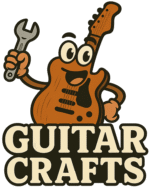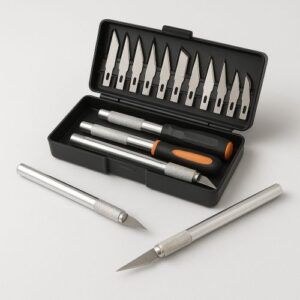Customizing a guitar isn’t just about pickups and finishes — it’s the little details that make your build truly yours. One of the best ways to add personality is through custom fretboard inlays.
In this guide on how to create custom inlays for your guitar fretboard, you’ll learn the aesthetic, technical, and creative steps involved — from choosing materials to cutting, shaping, and installing your own inlay designs.
Whether you’re upgrading a kit guitar or breathing new life into an old axe, custom inlays let you add a personal signature to your instrument.

Introduction to the Art of Custom Guitar Fretboard Inlays
Why Custom Fretboard Inlays Matter to Guitarists
Fretboard inlays aren’t just dots to mark positions — they’re a canvas for creativity. For many players, custom inlays become a signature element, a visual representation of their personality, story, or brand. These details set your instrument apart, especially if you’re building from a kit where personalization is part of the fun.
Enhancing Aesthetics and Personal Expression Through Inlays
Whether you prefer intricate vines, minimalist geometric lines, or bold thematic artwork, custom inlays can completely transform the look of your guitar. The right design adds character, presence, and visual energy — whether you’re after a vintage vibe or something futuristic and modern.
A Brief Look at the History and Cultural Significance
Historically, ornate inlays appeared on classical and flamenco guitars to showcase craftsmanship. In blues and rock, pearl and abalone inlays became iconic on custom shop builds. Today, inlays can represent anything — cultural symbols, family motifs, artwork, or abstract patterns — turning your fretboard into a personal canvas.
Understanding Custom Fret Inlays: What You Need to Know
Can You Get Custom Fret Inlays?
Absolutely. You can design your own, order pre-made inlay sets or collaborate with a luthier. If you’re building from a kit, many sellers allow you to select or upgrade to custom inlays. You can also retrofit an existing guitar with new inlays, although it’s more involved.
For those just getting started with electric kits, check out our Step-by-Step Guide To Building Your First Electric Guitar Kit to understand how inlays fit into the broader build process.
Materials Commonly Used for Custom Inlays
- Mother of Pearl – Classic, shimmering, and elegant.
- Abalone – Iridescent and colorful with lots of visual depth.
- Wood – Subtle and organic, great for minimalist or natural designs.
- Metal – Adds a sleek, modern touch.
- Plastic/Resin – Affordable and flexible for color and pattern work.
🌟 Amazon Product Suggestion:
✔️ World of Shell Inlay Supplies – 1 oz White Mother of Pearl Blanks
(.040″ Thickness)
A premium pack of bright, shimmering Mother of Pearl pieces — perfect for creating custom fretboard inlays on electric guitars, acoustics, mandolins, and more. These blanks are hand-selected, clean, and ready to cut into almost any shape you need.
Why it’s great:
✔ Ideal thickness (.040″) for guitar fretboard inlays
✔ Clean white pearl with strong shimmer and visual pop
✔ Hand-selected pieces — no dull or muddy shells
✔ Assorted shapes give you creative freedom for designs
✔ Works beautifully with hobby knives, micro saws, and needle files
✔ Perfect for beginners and experienced builders alike
🌟 Amazon Product Suggestion:
✔️ 10Pcs Guitar Abalone Inlay Material
Flat Shell Pieces for Custom Fretboard Work
A vibrant set of polished abalone blanks with dramatic color shifts — perfect for creating bold, eye-catching inlays on electric guitars, acoustics, mandolins, and more. Each piece is flat, smooth on at least one side, and ready to shape into custom patterns.
Why it’s great:
✔ Beautiful iridescent colors that pop under stage lighting
✔ Flat, workable pieces that are easy to cut and shape
✔ Perfect size for fretboard dots, symbols, vines, initials, and custom artwork
✔ Each blank has unique natural patterns — no two look the same
✔ Affordable option for beginners wanting a custom-shop look
✔ Great contrast on rosewood, ebony, and maple fretboards
🌟 Amazon Product Suggestion:
✔️ Jetmore 16-Piece Precision Craft Knife Set
Perfect for trimming copper tape, cutting shielding templates, and making clean cavity lines
This 16-piece Jetmore hobby knife kit gives you sharp, clean control for any detailed electric-guitar work. Whether you’re trimming copper foil inside a tight control cavity or shaping a clean edge around a pickguard shield, this set delivers the accuracy and stability cheap “best-seller” knives just can’t touch.
With 3 craft handles and 13 SK5 steel blades, you always have the right blade for the job — and the protective case keeps everything organized for fast swaps during wiring or shielding.
Why It’s Great:
✓ Ultra-sharp SK5 steel blades — perfect for cutting copper tape cleanly
✓ Multiple handles — better grip and better control inside tight guitar cavities
✓ Great for pickguards, templates, & shielding masks
✓ Precision cuts — reduces wrinkles, gaps, and lifting edges
✓ Compact case — keeps blades safe and organized in your toolkit
✓ Low cost, high value — ideal upgrade from budget knife sets
Each material has its own carving and finishing quirks, so choose based on your tools, experience, and the level of detail you’re aiming for.
Design Considerations: Patterns That Resonate
When designing inlays:
-
Match the scale length and fret spacing — complex patterns may not fit cleanly on shorter-scale necks.
-
Choose a theme that tells a story, like celestial symbols, tribal motifs, initials, animals, or geometric shapes.
-
Keep the design cohesive. If your guitar has a specific finish, tone wood, or color palette, match your inlay style and materials so everything looks intentional.
Step-by-Step Guide: Adding Inlays to a Fretboard
Preparing Your Guitar: Tools and Materials Needed
Here’s what you’ll need:
-
Template or sketch of your inlay design
-
Inlay material (pearl, abalone, wood, etc.)
-
Dremel or precision router
-
Fretboard (ideally before frets are installed)
-
Epoxy or CA glue
-
Razor blade / sandpaper
-
Protective mask and goggles
Don’t forget, before doing detailed fretboard work, make sure you’ve already addressed the truss rod adjustment and neck relief, so your inlay depth stays accurate.
Adding the Inlays: Step-by-Step Process
-
Sketch and Plan – Map out your design on paper or use digital tools like Inkscape, Illustrator, or any vector program you prefer. (I personally use CorelDRAW)
-
Mark the Fretboard – Lightly trace your inlay outlines onto the wood using a pencil or stencil.
-
Rout the Cavities – Use a Dremel with a precision base to cut the cavities, staying carefully inside the traced lines.
-
Fit the Inlays – Shape your inlay pieces with files and sandpaper until they sit flush in the routed pockets.
-
Glue It In – Use CA glue or epoxy to secure the inlays into place.
-
Level and Sand – After the glue cures, trim excess with a razor blade, then sand with fine-grit paper until the surface is perfectly flush.
-
Finish the Fretboard – Apply fretboard oil or lacquer (depending on wood type) to seal and protect the surface.
Want more hands-on guitar building tips? Explore our article on Essential Tools Every Electric Guitar Kit Builder Should Have.
Mastering the Craft: How Inlays Are Made
Overview of the Inlay Creation Process
Professional inlays are typically CNC-cut or hand-carved with extreme precision, then fitted into pre-milled fretboards. DIY methods rely more on manual cutting, shaping, and filing using jeweler’s saws, rotary tools, and fine abrasives. Both approaches can produce stunning results — it just comes down to tools, skill, and the time you’re willing to invest.
Techniques: Pro Luthiers vs. DIY
Professionals:
-
Use laser cutters or CNC machines for perfect consistency.
-
Design inlays with custom 2D/3D software.
-
Incorporate binding, purfling, and multi-material inlays for complex designs.
DIY Builders:
-
Rely on templates, patience, and steady hand tools.
-
Can achieve impressive results with simple equipment and careful shaping.
Common Challenges and Fixes
-
Cavity too deep or wide: Fill gaps with tinted epoxy and retry.
-
Cracked inlays: Work slowly and carefully, especially with brittle materials like mother of pearl.
-
Uneven surface: Sand gradually with flat sanding blocks until flush.
👉👉 Pro Tip: Start with simple inlay shapes like dots, blocks, or diamonds before attempting vines, animals, or custom symbols. Clean early results build confidence and make advanced designs way easier later.
Evolving Your Instrument: Changing Fretboard Inlays
Can You Change Fretboard Inlays?
Yes — but it’s tricky. If your guitar has dot or block inlays, you can carefully route them out and replace them. For more complex patterns, multi-piece designs, or anything involving binding, working with a professional is often the safest choice.
Not sure if this is the right time for an upgrade? Revisit our guide on Customizing Your Electric Guitar Kit With Unique Fretboard Inlays.
Assessing Risks and Benefits
Risks:
-
Damaging the fretboard
-
Weakening fret slots
-
Uneven finish or mismatched filler
Benefits:
-
Improved aesthetics
-
Stronger personal connection to the instrument
-
Potential resale value boost (especially for custom or artistic guitars)
Tips for Working With Professionals
-
Bring sketches or reference photos to your consultation.
-
Choose luthiers with proven inlay portfolios.
-
Set clear expectations about turnaround time and cost.
Final Thought…
Creating custom fretboard inlays is one of the most satisfying ways to personalize your guitar. Whether you’re building from scratch or upgrading your favorite axe, these tiny artworks can tell your musical story every time you play. With the right tools, materials, and creativity, your fretboard becomes more than a guide…
Craft it. Play it. Own it!
Ready to take your guitar passion beyond the workbench?
See how I built GuitarCrafts.com using the training at Wealthy Affiliate — you can do the same.
👉 Build Your First Website With Wealthy Affiliate (Free)





This guide is beautifully thorough—custom inlays really do elevate a guitar from a finished product to a personal statement. I love how you balance the artistic side—choosing motifs that speak to personality or story—with the hands-on technique of routing, fitting, and finishing. Emphasizing the right tools, from Dremels to templates, and the importance of precise planning before carving gives a real sense of confidence for anyone considering this project.
I also appreciate how you address the history of inlays—how they began as craftsmanship markers and have become deeply personal, artistic touches on modern builds. Highlighting risks like routing cavities too deep or uneven sanding makes the guide feel both creative and grounded.
One detail that stood out: your tips for managing brittle materials like pearl or abalone with extra patience and restraint. That wisdom alone can make all the difference between a smooth install and a cracked moment!
Thank you so much! I’m thrilled to hear the guide resonated with you. Custom inlays are one of those details that let builders really leave their personal mark on a guitar, and it’s great to know the balance of artistry and technique came through.
I’m especially glad the tips on brittle materials like pearl and abalone stood out. A little patience really does go a long way, and avoiding that “cracked moment” is always satisfying! It’s rewarding to share techniques that help builders feel confident tackling something that might seem intimidating at first.
Hearing that the historical context and practical advice were useful makes putting these guides together all the more worthwhile. I hope it inspires many builders to create inlays that are both beautiful and personal!
Thanks again,
~Wayne
This is one of the clearest guides I’ve read on this topic. Divorce can bring so much confusion, but you show practical steps to ease the stress for children. I think naming emotions and letting kids know their feelings are normal is very powerful. Many parents skip that part. I also love your reminder about routines because children rely on stability.
Thank you for your thoughtful comment! It seems like this might have been intended for a different page, but I really appreciate you taking the time to share your insights. Your points about acknowledging emotions and maintaining routines are excellent advice for any parent navigating a challenging situation.
~Wayne